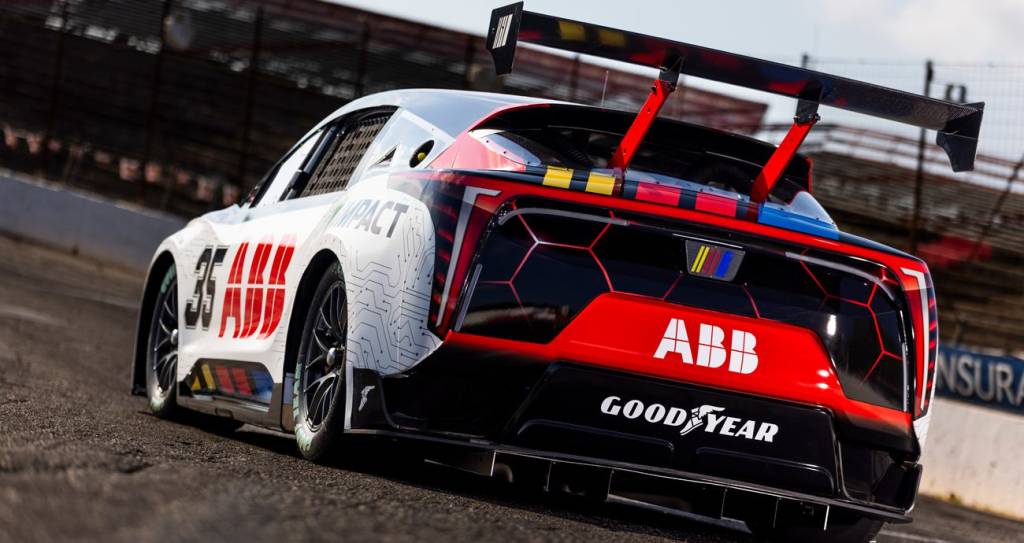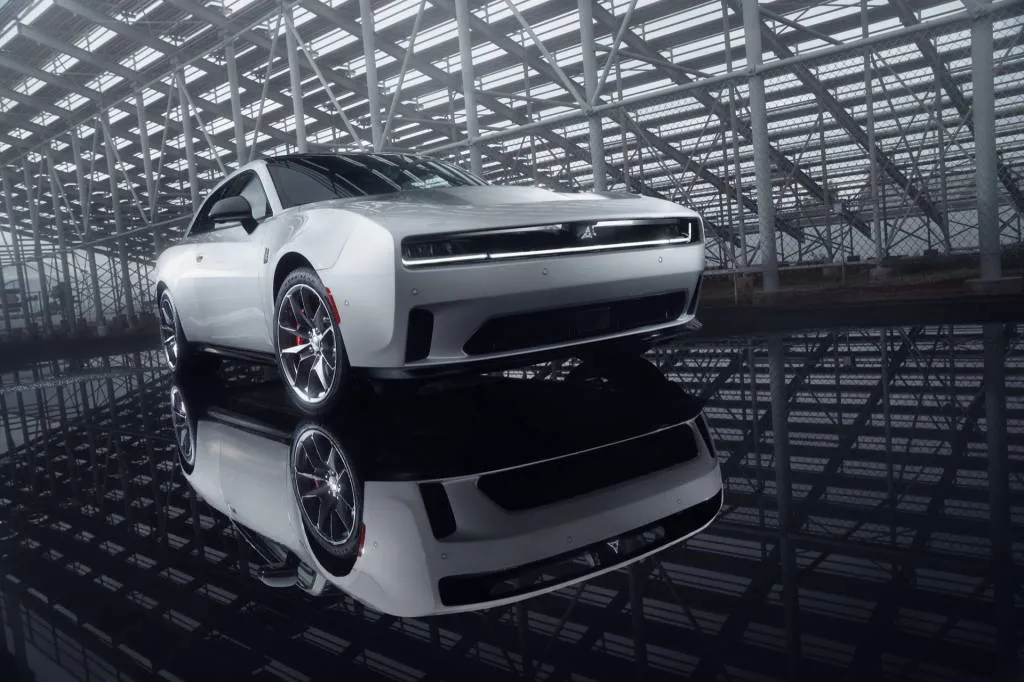NASCAR surprised attendees at its Chicago Street Race on Saturday with the debut of a fully electric SUV prototype.
It’s so surprising, perhaps, because the race series hasn’t even gone hybrid yet. NASCAR remains a race of thirsty, loud V-8 engines and rear-wheel-drive cars with rear-mounted manual transmissions.
And while the organization is making no suggestion of going all-electric next year, or even this decade, the prototype is surely an indication it’s thinking of the day when NASCAR will.
The NASCAR EV Prototype has all-wheel drive and is powered by three six-phase motors—one in front, two in back—potentially producing more than 1,300 hp and rolling on four Goodyear Racing Eagle tires. A 78-kwh battery pack powers the vehicle, and it emphasizes regenerative braking that NASCAR says makes the car “ideal for road courses and short oval tracks.”

NASCAR electric race car prototype
Its body is made of “sustainable flax-based composite, with its steering, suspension, brakes, and wheels all derived from the current race cars.
The prototype was developed with the charging and automation supplier ABB, which is now the car-racing league’s official partner for greening and very much involved in Formula E and F1.
The road to electrify the “stock car”
While the “S” and the “C” in NASCAR stand for stock car, the league’s race cars have not had much to do with production cars.
It started to change that in 2022, with its so-called Next Gen car that updated the racers’ components, aiming to better match those of production cars on a component basis, even if not as a whole. For instance, it finally dropped the old solid-rear-axle layout for an independent rear suspension.
NASCAR appears in a bind, as the organization has pledged to green the race series while its fan base appears not to value that shift. When it introduced its NextGen car, NASCAR said that a hybrid powertrain might arrive by 2024. But with that shift nowhere in sight, the soonest that’s estimated to arrive now is around 2027—despite current competition cars emulating the Ford Mustang Mach-E, Toyota bZ4X, and Chevrolet Blazer EV.
Zero-emissions pace cars happened long ago. The Ford Focus Electric became the first NASCAR EV pace vehicle in 2012, and the Toyota Mirai paced NASCAR in 2015. And some NASCAR drivers stood behind EVs even before then.
In April 2023, NASCAR committed to its first long-term carbon emissions goal and “the beginning of a new era in sustainability for America’s top motorsport.” That included a goal to cut its carbon footprint to zero across its core operations by 2035.

2024 Ford Mustang Dark Horse NASCAR Cup Series race car
Still an arena of 5-mpg guzzlers
NASCAR racers’ fuel consumption hasn’t changed much in decades and remains around 5 mpg during races. Over a season NASCAR’s fuel load has been estimated at around 2 million gallons—the same amount of gasoline that’s used by about 5,000 vehicles (30 mpg, 12,000 miles) in a year.
Formula E cars, on the other hand, complete their entire race on a full charge of less than 47 kwh—or the energy equivalent of about 1.4 gallons of gas. NASCAR race cars might use around 80 gallons in a race, admittedly much longer.

2024 Nissan GT-R Skyline Edition
Could EVs bring the “stock” back?
As Nissan recently argued, too, Formula E is providing more of a testbed for production vehicle technologies—like its e-4orce all-wheel drive system for EVs, and future performance applications for it.
The more appropriate question in NASCAR’s mission to green itself may be whether or not its target audience is ready to say farewell to the era of gas-guzzling V-8s.

2024 Dodge Charger Daytona
There’s a market test on the way. The EV potentially set to charge the NASCAR crowd up the most may be the 2024 Dodge Charger Daytona EV, which harks back to the heritage Daytona, the first vehicle to break 200 mph on a NASCAR track in 1970. The Dodge EV obviously won’t have the same level of gasoline fumes as the original, but it will include a “bone shaking” Fratzonic Chambered Exhaust system that relies on an amplifier and tuning chamber—perhaps striking the right mix of old and new that will eventually be necessary to sell the NASCAR crowd on EVs.
Content Disclaimer and Copyright Notice
Content Disclaimer
The content provided on this website is sourced from various RSS feeds and other publicly available sources. We strive to ensure the accuracy and reliability of the information, and we always provide source links to the original content. However, we are not responsible for the content’s accuracy or any changes made to the original sources after the information is aggregated on our site.
Fair Use and Copyright Notice
This website may contain copyrighted material, the use of which has not always been specifically authorized by the copyright owner. We believe this constitutes a “fair use” of any such copyrighted material as provided for in section 107 of the US Copyright Law.
In accordance with Title 17 U.S.C. Section 107, the material on this site is distributed without profit to those who have expressed a prior interest in receiving the included information for research and educational purposes. If you wish to use copyrighted material from this site for purposes of your own that go beyond fair use, you must obtain permission from the copyright owner.



